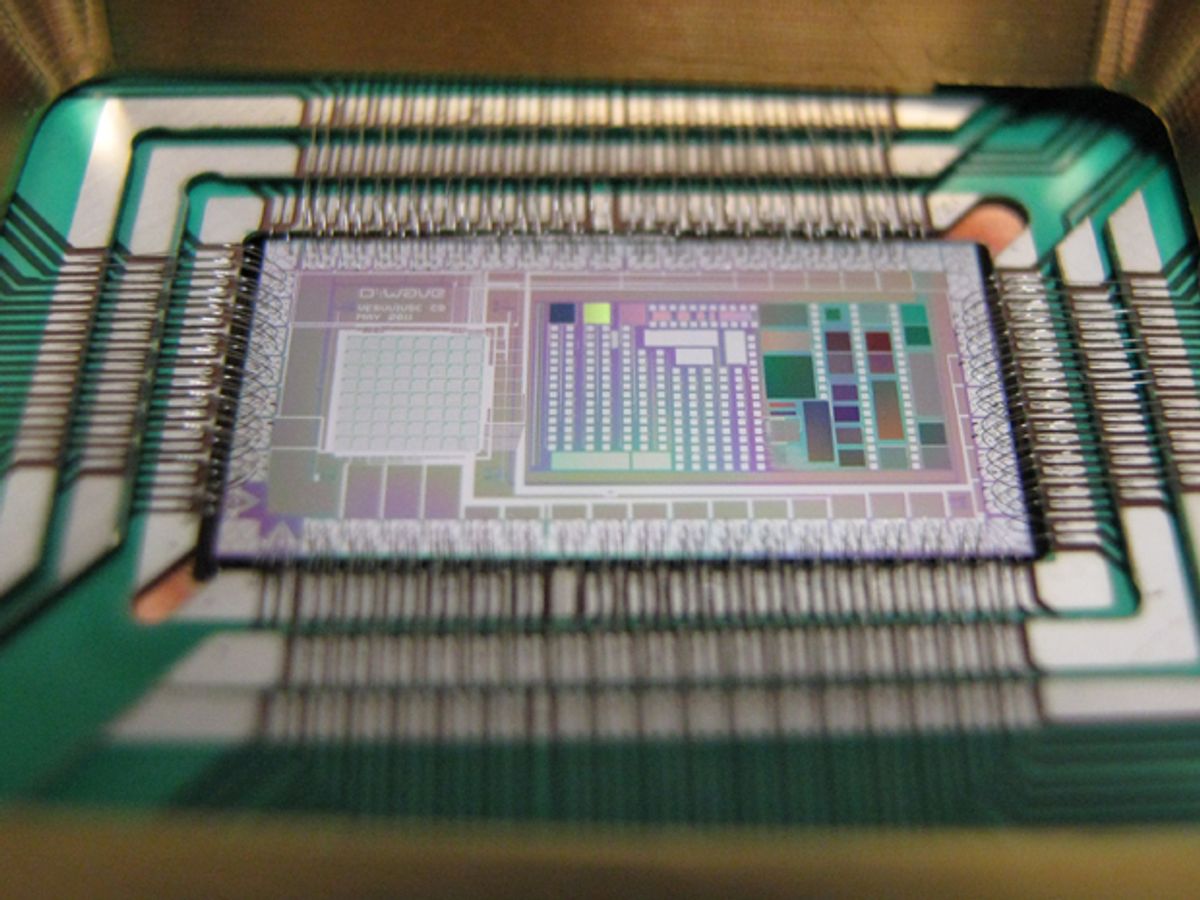D-Wave's claim to having built the world's first commercial quantum computers depends upon the workings of helium-cooled machines chilled to just 20 millikelvin (-273 degrees C).That frigid temperature is necessary to prevent thermal "noise" from overwhelming any quantum effects that might be present in the machines. But now researchers have come up with a "tunable noise knob" that allows them to collect a wider range of experimental data to test whether D-Wave's machines actually harness the spooky effects of quantum mechanics in their computing processes.
Their recent paper titled "Distinguishing Classical and Quantum Models for the D-Wave Device" is the latest to weigh in on the raging controversy about whether D-Wave's machines actually perform quantum computing. Several groups of researchers independent of D-Wave have presented evidence on both sides of the debate by comparing experimental results from D-Wave machines with models of classical computing and quantum computing to see which model the data fits best. But the new research took a different approach by adjusting the scale of the problems programmed into the D-Wave machine's processor to effectively increase or decrease the effect of thermal noise. In the end, tests at different thermal noise levels showed the quantum computing model fit the new results much better than the three classical computing models used in past papers.
"By being able to tune the noise, it’s clear that the 'master equation open quantum model' qualitatively fits the results for the experiment quite well," says Paul Warburton, reader in Nanoelectronics at the University College of London. He and colleagues at the University of Southern California reported their work 17 March on the arXiv preprint server.
Quantum computing offers the exciting possibility of performing many calculations in parallel by using quantum bits (qubits) that can exist simultaneously as both a 1 and 0, as opposed to classical computing bits that exist as only a 1 or 0. Rather than use the traditional logic-gate model of computing, D-Wave has built its machines based on "quantum annealing"—a method of tackling optimization problems. Solving optimization problems means finding the lowest "valley" in a problem landscape with peaks and valleys.
Controversy has surrounded D-Wave's machines in part because they are like black boxes with few parameters or "knobs" that outsiders can tweak or manipulate. That black box design is great for D-Wave customers such as Google and Lockheed Martin who want the machines to solve specific problems without needing to know about all the quantum mechanics going on inside, Warburton says. But he adds that the same design has limited attempts to figure out whether the D-Wave machines are actually harnessing the "spooky" effects of quantum physics.
The black box design means Warburton and his colleagues could not directly adjust the 20 millikelvin operating temperature of the D-Wave Two machine they tested. Instead, they changed the energy scale of the optimization problems programmed into the D-Wave computer chip—a process that involved changing the heights and depths of the peaks and valleys in the problem landscape without changing the overall shape. They tested this process on groups of 40 qubits.
The largest energy scales seemed to correspond to minimal thermal noise and to system behaviors related to quantum annealing. By comparison, the smaller energy scales corresponded with greater thermal noise and system behaviors that leaned toward a classical computing model of annealing. Still, it was the quantum model that fit best with the overall range of behaviors shown across all energy scales. D-Wave has even claimed that some thermal noise can actually help quantum annealing—a premise not borne out yet by independent research.
This does not rule out the possibility of other researchers coming up with new classical computing models that will also explain the experimental results, Warburton warns. So the "arms race" between new computing models and new experimental data related to D-Wave machines will likely continue. Warburton's research also steered clear of the equally controversial question of whether D-Wave machines will ever demonstrate the "quantum speedup" that would show them to be definitively superior to classical computers at solving certain problems. Researchers have not found any evidence of a quantum speedup so far.
One big question mark hanging over D-Wave's success or failure in its quantum computing venture is whether its machines can maintain their qubits' "coherence"—their ability to hold a quantum state—as the company builds machines with ever-more qubits. Independent researchers all agree that coherence is a problem D-Wave must solve as it tries to establish itself as the undisputed leader in commercial quantum computing. (See IEEE Spectrum's overview of the evidence for and against D-Wave's machines from the December 2013 issue.)
Another question is whether D-Wave's qubits can successfully harness the quantum effect of entanglement, allowing them share their quantum states. D-Wave has built computers with up to 512 qubits so far and plans to scale up into the thousands of qubits, but there is no evidence that the machines have been able to show coherent, entangled quantum behavior across all the qubits, Warburton says. In fact, the indirect signs of quantum behavior detected so far might just come from qubits being entangled with their immediate neighbors.
"The whole theoretical premise of the adiabatic quantum model [quantum annealing] is based on coherence across all qubits," Warburton says. "Maybe there is some quantum speedup achievable even with limited entanglement. We don't know."
Jeremy Hsu has been working as a science and technology journalist in New York City since 2008. He has written on subjects as diverse as supercomputing and wearable electronics for IEEE Spectrum. When he’s not trying to wrap his head around the latest quantum computing news for Spectrum, he also contributes to a variety of publications such as Scientific American, Discover, Popular Science, and others. He is a graduate of New York University’s Science, Health & Environmental Reporting Program.



